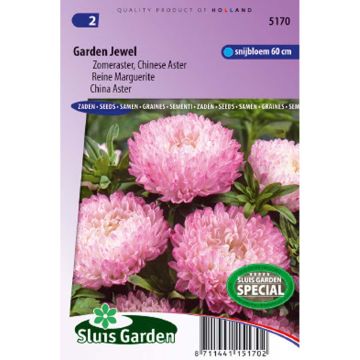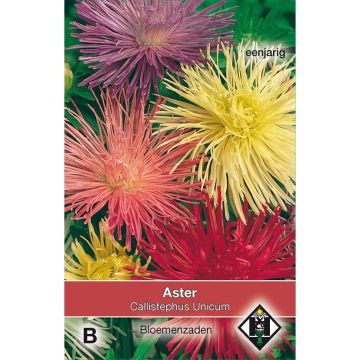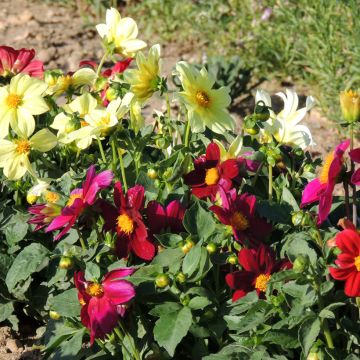

Callistephus chinensis Matsumoto Blue Ocean Mix seeds
Callistephus chinensis Matsumoto Blue Ocean Mix seeds
Callistephus chinensis Matsumoto Blue Ocean Mix
China Aster, Annual Aster
This item cannot be shipped to the selected country
Dispatch by letter from €3.90
More information
Dispatch by letter from €3.90
More information
Schedule delivery date,
and select date in basket
This plant carries a 6 months recovery warranty
More information
We guarantee the quality of our plants for a full growing cycle, and will replace at our expense any plant that fails to recover under normal climatic and planting conditions.
Seed-only orders are dispatched by sealed envelope. The delivery charge for seed-only orders is €3.90.
Does this plant fit my garden?
Set up your Plantfit profile →
Description
The Annual Daisy 'Matsumoto Blue Ocean Mix' is a blend of cultivars in blue, blue and white, and sky blue colours, depending on the plants. The flowers are rather small (5 cm), semi-double, borne on strong stems, ideal for cutting. This annual flower is quite resistant to fusarium, easy to grow and bloom. Sow under glass or directly in the ground. Cultivate in full sun, in fertile and well-drained soil.
The Annual Daisy, Callistephus chinensis, also known as Chinese Aster, is a Chinese annual plant of the Asteraceae family. This ancient flower has given rise to numerous varieties for borders and cut flowers. 'Matsumoto Blue Ocean' brings together three different cultivars: the first produces blue flowers, the second produces bi-coloured blue and white flowers, the third produces light blue flowers. The plants reach a height of 70 cm in just a few weeks. They form well-branched clumps, with robust stems carrying oval leaves with toothed edges. The flowers are semi-double, 5 cm diameter heads, blooming from June to September. Each plant germinates, blooms, and then dies in autumn.
The Annual Daisy 'Matsumoto' is a regular feature of summer borders. The 'Blue Ocean Mix' selection creates fresh displays, to be combined with white or pink varieties. Plant them in large clumps, and you can pick their flowers to create rustic bouquets throughout summer. Combine them with cosmos, snapdragons, and perennial salvias with blue or violet flowers ('Mainacht', 'Caradonna', 'Lyrical Blues', etc).
Flowering
Foliage
Plant habit
Botanical data
Callistephus
chinensis
Matsumoto Blue Ocean Mix
Asteraceae
China Aster, Annual Aster
Cultivar or hybrid
Other China Aster seeds
Planting and care
Sowing of 'Matsumoto Blue Ocean Mix' daisies: It is advisable not to sow these plants two years in a row in the same spot. Sow outdoors, from April to May, to transplant in place as soon as the plants have 2 to 4 leaves, 40 cm apart, in well-tilled, moist, and well-manured soil, in a sunny location. Water frequently, but sparingly. It is good to transplant several times while keeping the root ball to promote root development and slightly slow down the growth of stems that may break under the weight of the flowers. For an earlier flowering, sow under a frame or on a bed, in trays, from February to April. Sow the Daisies in trays filled with sand and peat under cover at a temperature of 16 to 20 °C. Repot in small individual pots when the seedlings have at least four leaves. Plant them in the garden when they reach a height of 15 cm. Install stakes to support the taller, double-flowering varieties.
A later sowing, in June, allows for staggered flowering until the end of autumn. This sowing can be done directly in place in the garden.
These plants like neutral or slightly chalky, fertile, well-drained soil and require a sunny exposure. Ample watering will be necessary twice a week in dry periods, but be careful to water the base and not the foliage, as China Asters are sensitive to powdery mildew. Remember to remove faded flowers as they appear to extend the flowering period and prevent the plant from weakening.
Sowing period
Intended location
This item has not been reviewed yet - be the first to leave a review about it.
Flower seeds
Haven't found what you were looking for?
Hardiness is the lowest winter temperature a plant can endure without suffering serious damage or even dying. However, hardiness is affected by location (a sheltered area, such as a patio), protection (winter cover) and soil type (hardiness is improved by well-drained soil).

Photo Sharing Terms & Conditions
In order to encourage gardeners to interact and share their experiences, Promesse de fleurs offers various media enabling content to be uploaded onto its Site - in particular via the ‘Photo sharing’ module.
The User agrees to refrain from:
- Posting any content that is illegal, prejudicial, insulting, racist, inciteful to hatred, revisionist, contrary to public decency, that infringes on privacy or on the privacy rights of third parties, in particular the publicity rights of persons and goods, intellectual property rights, or the right to privacy.
- Submitting content on behalf of a third party;
- Impersonate the identity of a third party and/or publish any personal information about a third party;
In general, the User undertakes to refrain from any unethical behaviour.
All Content (in particular text, comments, files, images, photos, videos, creative works, etc.), which may be subject to property or intellectual property rights, image or other private rights, shall remain the property of the User, subject to the limited rights granted by the terms of the licence granted by Promesse de fleurs as stated below. Users are at liberty to publish or not to publish such Content on the Site, notably via the ‘Photo Sharing’ facility, and accept that this Content shall be made public and freely accessible, notably on the Internet.
Users further acknowledge, undertake to have ,and guarantee that they hold all necessary rights and permissions to publish such material on the Site, in particular with regard to the legislation in force pertaining to any privacy, property, intellectual property, image, or contractual rights, or rights of any other nature. By publishing such Content on the Site, Users acknowledge accepting full liability as publishers of the Content within the meaning of the law, and grant Promesse de fleurs, free of charge, an inclusive, worldwide licence for the said Content for the entire duration of its publication, including all reproduction, representation, up/downloading, displaying, performing, transmission, and storage rights.
Users also grant permission for their name to be linked to the Content and accept that this link may not always be made available.
By engaging in posting material, Users consent to their Content becoming automatically accessible on the Internet, in particular on other sites and/or blogs and/or web pages of the Promesse de fleurs site, including in particular social pages and the Promesse de fleurs catalogue.
Users may secure the removal of entrusted content free of charge by issuing a simple request via our contact form.






















































